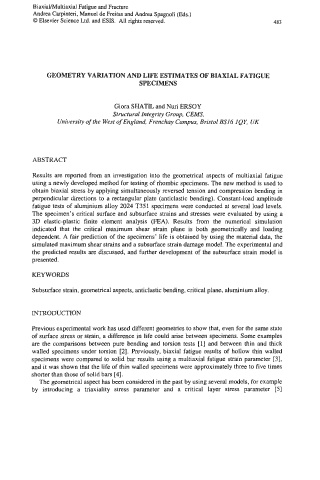Page 499 - Biaxial Multiaxial Fatigue and Fracture
P. 499
BiaxiaVMultiaxial Fatigue and Fracture
Andrea Carpinten, Manuel de Freitas and Andrea Spagnoli (EMS.)
0 Elsevier Science Ltd. and ESIS. All rights reserved. 483
GEOMETRY VARIATION AND LIFE ESTIMATES OF BIAXIAL FATIGUE
SPECIMENS
Giora SHATIL and Nuri ERSOY
Structural Zntegrity Group, CEMS,
University of the West of England, Frenchay Campus, Bristol BS16 IQX UK
ABSTRACT
Results are reported from an investigation into the geometrical aspects of multiaxial fatigue
using a newly developed method for testing of rhombic specimens. The new method is used to
obtain biaxial stress by applying simultaneously reversed tension and compression bending in
perpendicular directions to a rectangular plate (anticlastic bending). Constant-load amplitude
fatigue tests of aluminium alloy 2024 T351 specimens were conducted at several load levels.
The specimen’s critical surface and subsurface strains and stresses were evaluated by using a
3D elastic-plastic finite element analysis (ITA). Results from the numerical simulation
indicated that the critical maximum shear strain plane is both geometrically and loading
dependent. A fair predtction of the specimens’ life is obtained by using the material data, the
simulated maximum shear strains and a subsurface strain damage model. The experimental and
the predicted results are discussed, and further development of the subsurface strain model is
presented.
KEYWORDS
Subsurface strain, geometrical aspects, anticlastic bending, critical plane, aluminium alloy.
INTRODUCTION
Previous experimental work has used different geometries to show that, even for the same state
of surface stress or strain, a difference in life could arise between specimens. Some examples
are the comparisons between pure bending and torsion tests [I] and between thin and thick
walled specimens under torsion [2]. Previously, biaxial fatigue results of hollow thin walled
specimens were compared to solid bar results using a multiaxial fatigue strain parameter [3],
and it was shown that the life of thin walled specimens were approximately three to five times
shorter than those of solid bars [4].
The geometrical aspect has been considered in the past by using several models, for example
by introducing a triaxiality stress parameter and a critical layer stress parameter [5]

